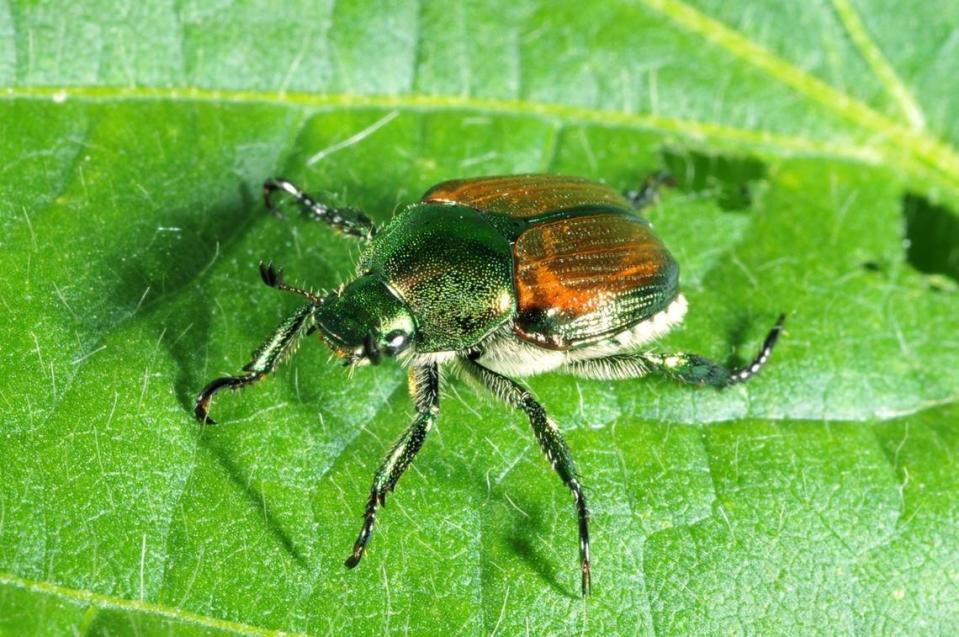There are about 250 green and yellow objects hanging throughout Boise. What are they?
This summer, 250 green and yellow objects that look a little like boxy, elongated badminton birdies appeared hanging on street signs and other structures around Boise. If you get close to them, they smell like flowers.
The objects are actually Japanese beetle traps and, for the time being, they’re empty.
Amid an infestation six years ago, Paul Castrovillo, entomologist at the Idaho Department of Agriculture, told the Idaho Statesman that Idaho’s goal was to eradicate the beetles over seven years.
Largely, the project has been a success. The Idaho Department of Agriculture detected four Japanese beetles in 2018. “So far in Boise, that’s the last four we’ve ever seen,” Castrovillo said over the phone.

They’re also destructive. Japanese beetles attack over 300 species of plants, including flowers and fruits. They feed on “pretty much everything except evergreens,” Castrovillo said.
The adults lay their eggs in grass in July. Once hatched, the juvenile beetles, called grubs, eat grass roots and devastate lawns and pastures.
“I love everything about insects, and I love all insects,” said Castrovillo, who also described the Japanese beetle as an old friend that he would see and play with as a child in the eastern U.S. But, he added, “Luckily, I was able to see that old friend and kill it.”
ATTRACTING BEETLES TO ERADICATE THEM
Introduced to New Jersey in 1916, Japanese beetles are still a problem in the eastern U.S. and in many other urban areas. The Idaho Department of Agriculture put out traps in Boise starting in 1990 to prevent an infestation. Once they’re established, it’s difficult to get rid of them, Castrovillo said.
Not until 2012 did the Department of Agriculture find a Japanese beetle in Boise. That year, it caught 56. In 2013, the number was 3,058.
The traps attract Japanese beetles with two scents: an odor released by female beetles to entice males and a flowery scent that lures both sexes.
The smell draws Japanese beetles to the area. Most don’t end up caught in the traps, said Marissa Schuh, a pest management educator at the University of Minnesota Extension, over the phone.
The ones that do get caught hit the yellow panels on the trap and fall down the cone and into the green beetle collector on the trap’s bottom.
“Seems like for the most part,” Castrovillo said, “they’re not smart enough to get out, or they just like what they’re smelling and just wander around in there until they die of starvation.”
Scientists found that yellow-colored panels were more attractive to Japanese beetles than other colored ones, wrote Steven Alm, a professor of entomology at the University of Rhode Island, in an email.
KILLING BEETLES THAT MISS THE TRAPS
The traps don’t kill most of the beetles, but they do show pest managers where to apply pesticides.
Since grubs need grass, in the western U.S., they tend to take hold in urban or irrigated agricultural areas. Grass is also the key to eradicating them, without killing many native insects.
Castrovillo and his team used a pesticide called acelepryn, which comes in the form of little pellets. When applied to lawns and then watered, the pesticide gets into the growing grass roots. The tiniest grubs that eat the roots then die and never reproduce.
When the Idaho Department of Agriculture still detected beetles in the area, it applied the pesticide in late May so that the grass roots had time to take up the pesticide. The toxin is only strong enough to kill the grubs right after hatching, when they’re still quite small.
Though acelepryn kills the tiny grubs, it’s “less toxic than table salt” to humans, mammals and birds, Castrovillo said.
SPOTTING INFESTATIONS BEFORE A PROBLEM DEVELOPS
In the past, Idahoans tampered with the traps. “People thought they were … ashtrays, or they thought they were piñatas,” Castrovillo said.
He asks people to please not touch them, so that the traps can continue to help the Department of Agriculture detect Japanese beetles before they become a threat.
“With all the people moving to Boise,” Castrovillo said, “there’s a good chance we’re going to get reinfested someday, and we want to keep our eyes open as much as possible.”
The Department of Agriculture still looks for Japanese beetles, but it also looks for other invasive species.
“I don’t really have to look for (murder hornets) because the general public has gotten so enthralled with it,” Castrovillo said. Luckily, “so far I’ve looked at about 350 photos, and they’ve always been native insects that were not murder hornets,” he said.
People who spot invasive species should check the Idaho Invasive Species website for details about identification and then call 1-877-336-8676 to report.
Sophia Charan writes for the Idaho Statesman on a fellowship through the American Association for the Advancement of Science. She has a Ph.D. in chemical engineering from the California Institute of Technology, where she focused on atmospheric chemistry, and a bachelor’s degree from Yale University.

